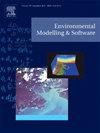基于物理先验知识的可解释人工智能滇池流域溶解氧预测
IF 4.8
2区 环境科学与生态学
Q1 COMPUTER SCIENCE, INTERDISCIPLINARY APPLICATIONS
引用次数: 0
摘要
溶解氧(DO)是水质监测的重要参数。然而,大多数现有的深度学习模型在模拟过程中忽略了DO与其他参数之间的物理关系,导致模拟值偏离了实际的物理规律。此外,深度学习模型固有的不透明性限制了它们的适用性。本文提出基于先验知识约束的双向长短期记忆网络(PKBiLSTM)模型来模拟滇池流域的DO水平。研究结果表明,PKBiLSTM模型的平均Kling-Gupta效率系数(KGE)为0.926,比门控循环单元(GRU)和分类提升(CatBoost)模型分别提高了3.35%和2.38%。实验表明,pH值在6.5 ~ 10范围内对DO浓度的影响最大。此外,影响DO的主要因素存在季节差异。这些发现强调了我们的方法在加强流域科学管理方面的潜力。本文章由计算机程序翻译,如有差异,请以英文原文为准。
Dissolved oxygen prediction in the Dianchi River basin with explainable artificial intelligence based on physical prior knowledge
Dissolved oxygen (DO) is a critical parameter for monitoring water quality. However, most existing deep learning models have overlooked the physical relationship between DO and other parameters during simulation, leading to simulated values that deviate from the actual physical laws. Moreover, the inherent opacity of deep learning models restricts their applicability. Here, we propose the prior knowledge-constrained bidirectional long short-term memory network (PKBiLSTM) model to simulate DO levels in the Dianchi Lake basin. Our results show that the PKBiLSTM model achieves an average Kling-Gupta efficiency coefficient (KGE) of 0.926, which represents a 3.35% and 2.38% increase compared to the gated recurrent unit (GRU) and categorical boosting (CatBoost) models, respectively. The experiments reveal that pH has the greatest effect on DO concentration within the range of 6.5–10. Furthermore, the primary factors affecting DO exhibit seasonal differences. The findings underscore the potential of our method to enhance the scientific management of watersheds.
求助全文
通过发布文献求助,成功后即可免费获取论文全文。
去求助
来源期刊

Environmental Modelling & Software
工程技术-工程:环境
CiteScore
9.30
自引率
8.20%
发文量
241
审稿时长
60 days
期刊介绍:
Environmental Modelling & Software publishes contributions, in the form of research articles, reviews and short communications, on recent advances in environmental modelling and/or software. The aim is to improve our capacity to represent, understand, predict or manage the behaviour of environmental systems at all practical scales, and to communicate those improvements to a wide scientific and professional audience.
 求助内容:
求助内容: 应助结果提醒方式:
应助结果提醒方式:


